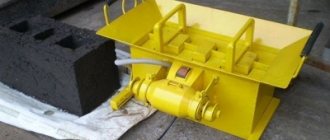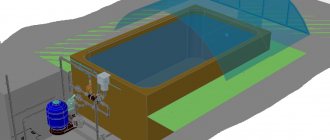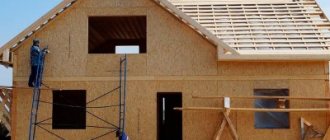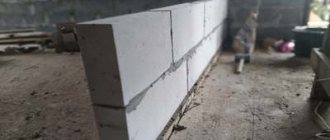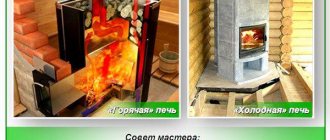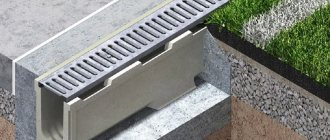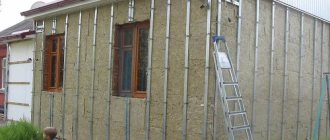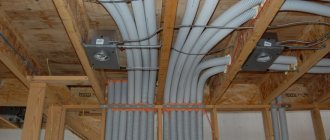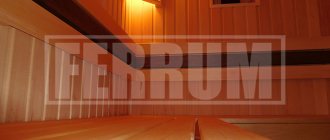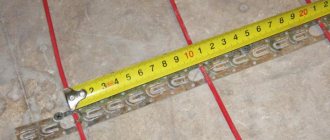Wood concrete is an unpretentious, environmentally friendly building material that allows you to build a strong, energy-efficient and reliable building.
Arbolite appeared in the last century, but only today is it gaining increasing popularity among private developers.
This material can be laid with your own hands, but for this it is important to study the process of laying wood concrete blocks in rows.
House made of arbolite blocks
The construction of a building such as an arbolite house begins with design and technical documentation.
Design
Documentation for the construction of any private house, which includes not only a building plan, but also information about the foundation, the building materials used, and the possibility of connecting to communications, must be agreed upon and approved by the relevant authorities.
On a note! Designing a building made of wood concrete is not much different from a typical plan for building a house made of expanded clay concrete.
Foundation construction
Due to the fact that wood concrete has the advantage of being light weight, you can choose absolutely any foundation for your house: on piles, on slabs, strip or columnar. Let's say we are building a house on a strip foundation. Work order:
- mark the dimensions of the foundation;
- We sample the soil to the required depth;
- We lay a layer of a mixture of sand and crushed stone on the bottom;
- compact it and spill it with water;
- install reinforcing elements;
- we install wooden formwork;
- pour sand-cement mixture inside the formwork;
- after hardening, lubricate the foundation with bitumen and lay two or three layers of waterproofing (for example, roofing felt);
- the surface limited by the foundation is covered with a mixture of sand and crushed stone and tamped;
- fill with a layer of concrete (more than 50 mm).
Base
This part of the structure is made using brickwork 40-50 cm high. The main function of the plinth is to protect the wood concrete blocks from the harmful effects of water.
We build walls
The technology for constructing walls from arbolite blocks is similar to the process of constructing walls from some other blocks (aerated concrete, foam concrete, expanded clay concrete) and is very similar to brickwork. We lay out the blocks in a checkerboard pattern, in rows, starting from the corner. We check the degree of vertical deviation using a level. To fasten the blocks we use a cement-sand mixture. After installing three rows, we take a break for 24 hours to allow the bonding solution to dry completely.
Advice! To prevent rapid removal of moisture from the mixture, we recommend moistening the blocks before laying.
The recommended wall thickness for a two-story house is 300 mm, and if higher - 400 mm. The thickness of the walls may be smaller (for example, 200 mm) if it is subsequently planned to use heat-insulating materials or external cladding. But remember: it’s warmer where the walls are thicker.
It is not necessary to reinforce walls built with wood concrete. But if you want to increase the strength of corners, junctions of walls, door and window openings, you can use reinforcing elements.
Interfloor ceilings
If you have limited funds, then wooden beams are a good option for flooring. If finances allow, then reinforced concrete slabs or metal channels are appropriate.
Roofing and rafter installation
The algorithm for installing rafters and installing roofing material for buildings made of wood concrete is the same as for buildings built from other building materials.
Important! Before installing the rafters, it is necessary to lay a layer of waterproofing on the wood concrete blocks
External and internal finishing
Any materials and methods are used for finishing. Finishing work can be done immediately after completion of construction or even during the process.
This video will help you how to build a house correctly:
A house made of wood concrete is built quite often - many people prefer this material. However, such a building has both advantages and disadvantages.
The article tells how to build a house from wood concrete and reviews about it.
Requirements for wood concrete walls
The optimal thickness of an arbolite load-bearing wall corresponds to gas or foam concrete and should be at least 300 mm for load resistance conditions and 400 mm for additional thermal protection.
In order to efficiently build walls of this size, the dimensions of the stone are standardized :
- reinforced - 600*300*200 mm;
- wide - 500*300*250 mm;
- medium - 500*300*200 mm;
- narrow - 500*250*150 mm;
- jumpers - 1500*250*300 mm.
The exact calculation of wall thickness must be established by the project. The size will depend on the location of the object, soil characteristics, climatic features and the height of the building.
Materials for house walls
Types of bulletproof formwork and the advantages of using it in the construction of foundations and walls of a house How to make clay blocks with your own hands Equipment for making blocks with your own hands.
Solution ratio Basic technical characteristics of slag, checking them and calculating the required quantity Main features of gas blocks and calculating the required amount for building a house Foamblocks for building a house: main functions, prices, ratings Foam block or gas block, which is better to choose for building the walls of a house Polystyrene blocks : sizes, price, pros and cons for their use in the home Advantages and main characteristics of prefabricated adhesives Measures, prices and other technical characteristics of clay blocks CIP panel: what is it, specifications, price, homeowner reviews Thermal blocks: main technical characteristics, expert reviews and owners of houses from them Technology of making wood concrete and building a house from it with your own hands
Wood concrete is a material consisting of sawdust and a cement mixture. It is simply ideal for the construction of bathhouse walls, as it is characterized by high thermal insulation characteristics.
Moreover, unlike traditional wood, it does not burn or rot. Next, we’ll look at how to build a bathhouse from wood concrete with your own hands.
Construction of a foundation for an arbolite bath
Arbolite is a fairly light material. In addition, the bathhouse usually does not have a particularly large area. Therefore, the foundation in this case may not be too powerful, a shallow strip.
It is being built in several stages:
The site for the construction of a wood concrete bathhouse is first marked using pegs and a cord; After this, a trench is dug. The width of the foundation should be such that after erecting the walls from inside the bathhouse, there remains a protrusion wide enough for laying joists under wooden floors; Drain pipes are laid; A 20-25cm layer of sand is poured onto the bottom of the ditch; Next, formwork is installed along the edges of the trench. It is desirable that the base of the bathhouse has a height of at least 40c; At the next stage, wooden blocks 5 cm thick are laid at the bottom of the pit, on which a reinforcing mesh is installed; After this, the concrete mixture is poured; The entire area under the future steam room is poured with a layer of 5-7 cm. In this case, a slope is made towards the opening of the drain pipe. At the last stage, the base is waterproofed. It is also necessary to coat it with bitumen from the inside.
Important: The foundation will gain sufficient strength to erect walls in about 4 weeks. During the first two weeks, the structure should be moistened daily to prevent cracks from appearing on it.
Walling
A do-it-yourself wood concrete bathhouse is often built from blocks.
In the first case, the masonry is done in exactly the same way as with brick. Before installation, each block must be wetted with water. The fact is that wood concrete absorbs moisture very well, drawing it out of the binder composition.
As the latter, sand-cement mortar or perlite mixture can be used. The seams should be no more than one centimeter thick.
Characteristics of the material according to GOST
The advantage of wood concrete blocks is their low weight, which does not require the installation of a complex foundation.
All blocks must have minimum acceptable indicators for the following characteristics :
- Thermal conductivity is in the range of 0.07 -0.16 W/(m•deg), if the walls are built with the designed thickness, technologically accurately, then such a house will not require additional heat and sound protection.
- The basic GOST for wood concrete blocks requires high bending strength of 0.7 - 1 MPa and compressive strength of at least 0.5 MPa. If the component composition is observed, ABs are capable of providing elastic resistance to significant external mechanical loads, and therefore cracks do not form on the surfaces of the walls, and living in such a cottage is absolutely safe.
- Shrinkage from 0.4 to 0.5%.
- The average density is 650 kg/m3.
- Moisture absorption is set in the range of 40-85%.
- Frost resistance - at least 50 cycles. This parameter allows the walls to withstand freezing/thawing cycles repeatedly, provided that the blocks have been protected from moisture penetration inside.
- Fire resistance. The maximum fire resistance of the material is normatively set in the range of 0.75 -1.5 hours, which ensures good fire safety of the object, despite the fact that the composition contains a lot of wood chips.
- Biostability - group 5.
- Sound absorption at 2000 Hz - 0.6.
Full information about the main technical characteristics in this article.
Wood concrete production technology at home
Producing wood concrete at home is attractive because it requires materials that can be purchased at a low price. But to make blocks with your own hands, you need to organize a mini-factory with a variety of equipment. In principle, the necessary equipment can be rented, although finding them is not so easy. In addition, you should study the composition of the mixture and the proportions of the ingredients contained in the blocks.
Product mixture composition
Wood concrete consists of the following components:
- Portland cement (not lower than grade M400);
- organic fillers - wood chips, flax kernels, hemp, cotton stalks, rice straw, etc.;
- chemical additives - slaked lime, liquid glass, aluminum sulfate, potassium chloride or calcium sulfate;
- water.
Proportions of components per 1 cubic meter
| Brand | Cement, kg | Organic filler, kg | Chemical additives, kg | Water, l |
| 15 | 250–280 | 240–300 | 12 | 350–400 |
| 25 | 300–330 | 240–300 | 12 | 350–400 |
In order not to get confused with brands and not to fill your head with unnecessary information, construction gurus use the following formula: 3 parts cement + 3 parts organic filler + 4 parts water = 1 cubic meter of material.
Block production equipment
In the process of manufacturing wood concrete, the following equipment will be required:
Drying finished blocks
- sawdust chipper (price: $2500);
- set of tampers (price: $153);
- mixing machine (price $1500);
- molds for pressing 30 pcs. (price 1500$);
- drying chamber (price $4,500);
- metal trays for block shapes (price: $400).
A total of about $10,000–12,000 is required to purchase equipment and materials (this, as they say, is all about technology). Yes, it’s a little expensive, but the availability of the necessary devices and raw materials guarantees the production of 500 cubic meters of solution per month. Not a bad indicator even for industrial volumes.
Do-it-yourself raw material production technology
The block creation workflow consists of the following steps:
- load wood into the installation;
- grind the wood to an acceptable size - length - about 25 mm, width - approximately 5 mm;
- keep the wood chips in the fresh air for 3 months so that the sucrose evaporates;
- treat the chips with calcium oxide;
- moisten sawdust with water;
- mix the moistened wood chips with cement;
- we process raw materials using one of the chemical additives - lime, liquid glass, potassium chloride, calcium sulfate;
- load the mixture into a mass mixing unit (concrete mixer);
- pour the resulting and well-mixed mass into molds lined with linoleum (to prevent sticking);
- shake the solution poured into the molds to remove air and compact it thoroughly, but it is better to use a vibrating table;
- we leave a free space on top - 20-25 mm and fill it with plaster mixture so that the blocks can boast of aesthetics on the front side;
- keep the mixture in the molds for 72 hours;
- take out the blocks;
- We put them on oilcloth and do not touch them for 3 weeks.
As you can see, the process is quite lengthy, requiring a certain patience and skill. As you understand, general manufacturing technologies are given here. But proper organization of production will allow you to produce 80–100 blocks daily. Two weeks of work and you are provided with building material for the walls of your future home or any other structure.
So what conclusions would I draw? Wood concrete is a good, warm, environmentally friendly and durable material, but it is expensive to make at home (subject to the purchase of all equipment). More precisely, this is a rather “long-lasting undertaking.” At the same time, self-made wood concrete is the key to a presentable, comfortable and durable structure!
Anecdote on the topic: Construction
A frightened newcomer comes running to the foreman: “I seem to have forgotten the wiring... So the foreman answers importantly: “Remember, guy, forever: we never forget about vodka here!” That's all
I hope that for someone I have filled in the gaps in knowledge about construction technologies. If you were interested, join our ranks of social groups and you will be aware of all the news on this blog. Good luck and warm walls to your home. Bye!
That's all. I hope that for someone I have filled in the gaps in knowledge about construction technologies. If you were interested, join our ranks of social groups and you will be aware of all the news on this blog. Good luck and warm walls to your home. Bye!
Wisdom Quote: What is the salvation of one is the ruin of another (Daniel Defoe).
Properties and scope of arbolite blocks
Arbolite blocks are a wall material of the lightweight concrete group, used in low-rise (up to 3 floors) construction. Their standard size is 200x300x500 mm. Most manufacturers offer a wider range of standard sizes. Residential buildings, low-rise commercial buildings, technical buildings, and outbuildings are used from arbolite blocks.
Residential buildings, commercial and technical buildings, and outbuildings are built from arbolite blocks
Wood concrete as a building material has a huge number of advantages:
- Low thermal conductivity;
- Minimal sound transmission;
- High vapor permeability;
- Biological resistance;
- Fire safety;
- Light weight;
- Convenient format;
- Environmental friendliness;
- Cost-effective and easy to install;
- Durability;
- Low cost.
Light weight and convenient format of wood concrete blocks save time and labor costs for builders
With proper production and use of wood concrete blocks, you will achieve savings on several expense items at once: a lightweight foundation, no additional thermal insulation, reduced heating costs, and a minimum of waste during construction.
The disadvantages of building materials include:
- The need for plastering of walls, protection from water.
- The need to use special masonry compounds - “warm” perlite solutions.
- Possibility of using only “breathable” finishing materials.
- Time spent on producing a sufficient number of products.
- Risk of damage to low-quality blocks by rodents.
Walls made of arbolite blocks should be plastered to protect them from water
What is wood concrete made from?
To produce wood concrete blocks you will need the following components:
- wood chips;
- chemical additives;
- cement;
- water.
Requirements for the size of wood chips according to GOST - length up to 25 mm, width 5–10 mm, thickness 3–5 mm
You can take chips of a different size, shavings, sawdust. But remember that too large a fraction reduces the strength characteristics of the block, and a small fraction increases its thermal conductivity.
Usually the raw material is pure pine and spruce wood, sometimes hardwood. Chips make up 80–90% of the total volume, which is why the material is often called wood concrete.
The wood concrete block consists of 80–90% wood, so it can be easily cut with a chainsaw
The wood is well dried - humidity no more than 23%. The inclusion of bark and wane up to 10% is allowed. The inclusion of leaves, pine needles, and straw is undesirable.
A chemical additive is necessary for the mineralization of wood chips - neutralizing the sugars and resins contained in wood fibers. These natural substances interfere with the adhesion of the cement mortar to the wood and impair its bonding. For mineralization the following are used:
- sodium sulfate (liquid glass).
- aluminum sulfate.
- aluminum chloride.
- calcium chloride.
Chemical additives can be used individually or in pairs in a 1:1 combination.
Cement should be taken only of grade M500, or, as a last resort, M400. It has maximum binding properties, hydrophobicity, and strength.
What is a cement bonded particle block?
Arbolite block (AB) is a building masonry product that belongs to the classification of lightweight concrete. The block has a rectangle in cross section with standard sides.
It is made from materials based on cement binder with filler from wood shredders with chemical additives that determine the production characteristics of the output product. For this type of block, organic filler is used.
The optimal combination of constituent elements in the production of AB makes it possible to create the design strength of the material, sufficient to erect houses up to 3 floors.
Marking of AB stones:
- B - block.
- SK - designed for wall masonry.
- NS/V/P - types of walls: external/internal/partition.
- A - type of noise protection, acoustic.
- R/UG/D - ordinary/corner/additional.
What does it look like in the photo?
The production of AB blocks in Russia has been standardized, its geometric and production characteristics were determined in 2022 by GOST No. 19222.
Wall material is available in two modifications :
- structural;
- thermal insulation.
The former are used as load-bearing internal and external walls, while the latter are less dense and are used as independent layers in heat, sound and noise protection systems for buildings.
The appearance of the AB depends on the manufacturing technology of the wall product:
- With a finished facing surface: cement-sand, granite chips and facade tiles
- In terms of screening size as a filler, the smaller the fraction, the higher the AB.
- With a construction internal finishing cement-lime-sand layer of at least 15 mm, which has strong anti-corrosion protection for steel building structures.
Composition: what is the material made from?
The AB composition must, according to GOST 19222.84, have the following material compositions: wood chips, straw after processing flax and rice. They are mixed with a binder, which is Portland cement or sulfate-resistant cement.
To improve the characteristics of the battery, mineral and chemical additives are added to the working mixture . Also, many manufacturers of such blocks add latex and PVA dispersion, which increase the strength characteristics and close the pores to prevent moisture from getting inside.
Additionally, plant waste is used as an organic filler, which, when ground, forms needle-shaped chips: branches and straw. Sawdust and even leaves can be added to the wood concrete mixture recipe with a critical ratio of 1:10 per m3.
All organic additives are kept in crushed form outside for 2-3 months, after treatment with lime milk. By dissolving 50 kg of slaked lime in 200 liters of water, you can process approximately 4 m3 of wood chips.
Wood concrete
This is exactly what the word “arbolit” sounds like when translated into Russian. In construction and technical terms, this is one of the forms of lightweight concrete, where the binder is cement, and the main filler is waste from the processing of raw materials of organic origin. Most of it is wood chips. The percentage of chemical additives is small and completely harmless to humans. The leading advantages of wood concrete are:
- 100% environmentally friendly;
- high bending strength;
- low thermal conductivity;
- high level of noise absorption.
In addition, wood concrete practically does not burn, is frost-resistant, belongs to group 5 in terms of biological resistance, is light in weight, and so on.
Thanks to all the above qualities, you can easily build a three-story house from wood concrete with your own hands or any other commercial and industrial premises. In addition, you can make wood concrete blocks or wood concrete for monolithic construction of walls yourself, which will significantly affect the savings in material resources during construction work.
Advantages and disadvantages
Due to its structure and characteristics, wood concrete (wood concrete) is endowed with both a number of positive qualities and some flaws.
In general, there cannot be a building material consisting of only advantages, otherwise it would be used everywhere, and the rest would be undeservedly forgotten. The advantages of wood concrete as a building material are obvious.
Thus, a block made of wood concrete has many advantages.
The disadvantages of wood concrete blocks include some nuances.
The manufacturer's ability to profit from the cement used in the production of blocks. In this case, the building material sharply loses its strength, thus, this minus eliminates some of the previously presented advantages. Similarly, a disadvantage that can nullify a number of advantages is the permissibility of changes by the manufacturer in the fraction of wood particles in the structure. It follows from this that it is likely that products will be produced with too large a fraction of wood chips or, on the contrary, the main share of the wood component may be sawdust
Both options have a great influence on the quality characteristics of the finished block and, consequently, the structure built from it. Wood concrete, due to the wood in its structure, is capable of absorbing water in significant volumes, which is why close attention must be paid to protecting wood concrete structures from water penetration. Another drawback is the frequent errors in the geometry of wood-concrete blocks; they, as a rule, are not very strong, but can lead to excessive consumption of masonry cement mortar. And it increases the thermal conductivity of the rebuilt wall, which is also difficult to call an advantage.
Having analyzed all the advantages and disadvantages of wood-concrete blocks, we can draw the appropriate conclusions.
Building materials should be used with caution for buildings with a high level of air humidity inside. Before purchasing, it is imperative to check the material and make sure of its quality characteristics.
It is necessary to evaluate the size and interweaving of wood particles located in the structure, check the absence of excessive formation of hardened cement mortar or components of products that are not tightly coupled to each other
Before purchasing, it is imperative to check the material and make sure of its quality characteristics. It is necessary to evaluate the size and interweaving of wood particles located in the structure, to check the absence of excessive formation of hardened cement mortar or components of products that are not tightly coupled with each other.
Arbolite - composition and manufacturing technology
Filler used
Wood chips, shavings or sawdust generated during wood processing are used as the base of the blocks.
Wood concrete is perfect for the construction of residential buildings, bathhouses, garages and other utility structures. As you can see, the scope of use is quite wide
The filler should be carefully prepared:
- clean from inclusions of foreign origin;
- grind to a size not exceeding 5x10x40 mm;
- dry thoroughly for three to four months;
- treat with lime mortar to prevent rotting.
Per cubic meter of wood chips you will need 0.5 tons of 15% lime solution. Wood waste is soaked for 3–5 days with periodic stirring. This reduces the concentration of sugar in the wood, which creates favorable conditions for the development of rot. You can use purchased material or grind it yourself at home using a wood chipper or crusher.
Components used
The following components are used for the production of blocks:
- Portland cement, which is a binder. Its content is 12–16%. This concentration is sufficient to bind the ingredients and ensure the strength of the products after removal from the molds;
- mineralizers that reduce water absorption and increase biological stability. Lime is used after slaking and settling, calcium chloride, liquid glass, and alumina.
Arbolite is a good, warm, environmentally friendly and durable material
Providing the required consistency of the wood concrete composition is achieved by adding water, which is absorbed by the aggregate, saturating it with the mineral substances included in the mixture. Depending on the brand of wood concrete composition, the ingredients are introduced in different ratios. In this case, the specific gravity of the blocks varies from 0.3 to 1.3 t/m3.
Wood concrete production technology
The standard technological process involves performing the following operations:
- Preparation of aggregate of required sizes.
- Dosing and mixing of components.
- Pouring the finished composition into molds and compacting.
- Drying in natural conditions.
- Removing products from molds.
- Settling for 14–20 days.
Equipment
To make wood concrete, you need the following equipment:
- feeding conveyor. It is a screw that provides accelerated supply of aggregate during the production of wood concrete in increased volumes;
- magnetic separator. It is installed after the auger and separates various metallic inclusions from the continuous flow of chips supplied for crushing;
The manufacturing technology of wood concrete involves its production in the same way as fiberboard, by mixing Portland cement with low-grade wood shavings
- chipping plant. Designed for preliminary grinding of wood chips to the required size using a rotor equipped with knives for cutting large raw materials;
- separating device. Sorts pre-shredded wood chips into fractions. Conditioned material is fed into the bunker, and coarse material is fed for additional crushing;
- crushers. Units are used in which repeated grinding is carried out with special hammers. They are hinged on a rotating rotor;
- dosing device. Provides portioned supply of components specified in the recipe to the mixing unit. Performs volumetric dosing;
- mixing mechanism. A conventional cyclic concrete mixer is used, in which the initial components are mixed for 10–15 minutes;
- special forms. They are a structure made of wood or steel. After hardening, the blocks can be easily disassembled for reuse;
- manual rammer. Allows you to quickly compact the wood concrete mixture poured into molds. During the compaction process, air escapes from the massif and the density increases.
To produce blocks on an industrial scale, a vibrating machine or vibrating table is used. They allow you to obtain products of increased density and excellent quality. Accelerated supply of raw materials into molds during the industrial production method is carried out by special concrete distributors.
Construction time
Regulatory technology allows you to build a arbolite 2-story residential building in a 10x10m plan in 3 months, when the work will be carried out by a team of specialists of 4 people. When constructing and manufacturing the material independently, the developer will need up to a year . These terms may be increased depending on the volume and actual construction experience of the contractor.
Wood concrete walls are built quite quickly; an experienced team can lift an entire floor in 5 working days. It will take 7-8 days to complete the armored belt and harden it.
When building wood concrete houses, the longest process is finishing. The simplest interior finishing: puttying and painting can be completed by a team of 3-4 people in 2 months; designer types of finishing work will take from 6 months to 2 years.
Exterior finishing with thermal insulation can be completed in a month; the cheapest and fastest is siding, and the longest is brick with a ventilation gap.
What mixture is used?
The building materials market is represented by a huge range of dry mixtures that ensure the strength of walls made of wood concrete panels. The choice of adhesive base determines:
- lifespan of the property;
- degree of thermal insulation in the room;
- degree of noise absorption in the room;
- degree of moisture absorption in the room;
- degree of air permeability in the room.
Each adhesive base format, designed for laying concrete, wood and mineral blocks, has advantages and disadvantages.
For laying walls made of arbolite blocks, you can purchase a ready-made composition based on quartz sand, cement, as well as polymer and mineral additives. Adhesive mixtures are often packaged in 25 kg bags.
Advantages:
- high degree of adhesion;
- structural strength;
- ease of installation;
- protection against mold and mildew;
- high degree of thermal insulation.
Flaws:
High price.
Preparation of the solution
If it is not possible to keep the wood chips in the air to destroy the sugars, they are subjected to chemical treatment: left in lime milk for 3 days. The wood waste is mixed from time to time. There is no need to dry the wood chips after this. It is only necessary to remove excess solution. In the process of laying such blocks, a solution of different composition is used.
Sand with cement
Recommended proportions of components: 1 share of M400 cement and 2 shares of sand. If you plan to use M500 cement, then prepare 3 parts of sand for 1 part of this material. The components are mixed dry using a construction mixer.
Perlite
Kneading begins by combining water (10 l) and a dry mixture of perlite (2 buckets). When the components are thoroughly mixed, cement is added to them (no more than 0.5 buckets). When working with perlite, it is necessary to wear a respirator, safety glasses and closed clothing.
Glue mixture
Standard scheme: 5 kg of adhesive (dry) and 5 liters of liquid. The mixture is left at rest for 5 minutes. Then the mixing process is repeated. The finished material must be used within 2 hours, then it will lose its properties.
The procedure and features of mixing the solution
First, sufficient sawdust is poured into a container or concrete mixer. After this, water is poured in. Special additives and liquid are mixed separately. At the next stage, the solution is added to a concrete mixer, where the sawdust is soaked. After these manipulations, cement is poured in small portions.
Block molding
Forms for the finished mixture are made or purchased. They should have handles, but without a bottom. Such structures are installed on a wooden base. The solution is poured into them. If the work is done with your own hands, the mixture is laid out in molds in layers, each time tamping the material using a manual vibrating platform. Air is periodically removed from the thickness of the mixture. To do this, the material is pierced with a rod. At the last stage, the surface of the workpieces is leveled, for which a metal strip is used - it helps to remove unevenness.
Technology for working with different solution densities
If the mixture turns out to be thick, then the blocks are placed tightly against each other “in a clamp.” The solution should fill the gaps well. The excess that appears on the resulting seams must be well leveled with a trowel along the plane of the row, stretching the mixture in the direction of the previous block.
Procedure:
- apply a layer of solution;
- install a block on it;
- perform forceful pressure on the previous one;
- align the block relative to the others and remove the protruding solution.
In the case of a liquid mixture, the laying is done end-to-end. In this case, the seams are not completely filled. By pressing adjacent elements, a natural distribution of the solution between the adjacent walls is obtained. This allows you to achieve uniform, identical seams. Remains of cement must be removed from the working level of the masonry.
Regardless of the type of mixture, the seams are cut at intervals of 2 rows. The process consists of additional application and uniform distribution of cement along the seams. This procedure will make the blocks stronger.
Be careful! It is necessary to constantly monitor the correctness of the wall connection angles and the position of each row of masonry. At the same time, if the solution has already “grabbed” with the block, then moving it is prohibited.
Composition and technology
Arbolit, from which houses were built en masse already 60 years ago, belongs to the family of lightweight concrete, which has now won a significant market share from brick. This is a composite (complex in composition) material consisting of the following components:
- Wood chips (chopped pine sawdust, crushed cotton stalks, flax or hemp stalks). The organic part is a filler and occupies 80-90% of the volume. Chips have a specific shape and size, which distinguishes wood concrete from sawdust concrete.
- Cement. Mineral binder. To make the block durable, Portland cement grades M400-500 are used.
- Mineralizer additives. They neutralize the sugar present in wood and affect the strength of wood concrete (improving the adhesion of wood chips to cement). Calcium chloride, soluble glass, aluminum sulfate are used (the latter is a food additive E-520, which is actively used in the confectionery industry and in fish canning factories).
Block making machine at work Source plantu.ru
The production of blocks is carried out on automated lines and is divided into stages:
- Preparations. The wood chips are crushed, soaked and treated with a chemical composition. If the wood chips are pre-aged in the fresh air for 4-6 months, no additives are needed; the sugar breaks down on its own.
- Moldings. The required, precisely adjusted amount of wood chips and cement are mixed and formed into blocks.
- Drying. On a brick press, the blocks are compacted, obtaining their final density and geometry corresponding to GOST.
Classification
Blocks, panels and slabs are made from wood concrete (another name for wood concrete). According to the state standard, wood concrete products do not require additional insulation. Products vary in density (percentage of sawdust), they are classified according to their purpose:
- Structural. Used for the construction of external walls.
- Thermal insulation. For interior walls.
Based on their dimensions, blocks are divided into: wide, medium, narrow and connecting. In addition, the elements are marked from 5 to 50 (strength indicator).
House made of wood concrete - fast, cheap, energy efficientSource plantu.ru
Specifications
Arbolite blocks are applicable in all climatic zones (there are buildings made of arbolite not only in the middle zone, but also in Antarctica, at the Molodezhnaya polar station). Such multi-purpose use was made possible thanks to the combination of technical characteristics of the material:
- Light weight. The density of structural blocks is 500-850 kg/m3, heat-insulating blocks - up to 500 kg/m3.
- Low thermal conductivity. In terms of parameter (0.11 W/(m*K)) it surpasses wood. A wall with a thickness of 0.3 m corresponds to 0.6-0.7 m of brick in terms of its ability to retain heat.
- Environmental friendliness and biostability Arbolite is safe for human health; the material does not rot, fungus and mice do not grow in it.
- Fire resistance. The material can withstand an open flame at a temperature of 1000°C for up to an hour and a half, then it begins to smolder.
- Sound insulation and vapor permeability The structure of the blocks absorbs sounds and supports natural ventilation and humidity regulation, which ensures a comfortable microclimate in the house.
Comparative characteristics of popular building materialsSource kafmt.ru
Homemade mistakes
The technological chain for the production of wood concrete is described in one phrase: a mixture of concrete and wood chips is placed in molds and dried without additional heating (firing). External simplicity is deceptive. The absence of obvious technological problems encourages home craftsmen to independently produce wood concrete blocks. Having decided to save money, a garage manufacturer is guided by the following misconceptions:
- Any wood chips will do (even sawdust from a sawmill).
- The brand of cement has a slight effect on the strength of the product.
- The mixture is concrete, so you can mix it in an ordinary household mixer and neglect the mineralizer.
- You can do without a press or assemble it yourself.
- The form is easy to construct from plywood or foam concrete. Since the mixture is thick, the formwork can be removed immediately, and the blocks will dry under a shed or in a barn.
Problem areas in masonry made from artisanal wood concreteSource optolov.ru
The output is a fragile product that crumbles along the edges and has incorrect proportions (not according to GOST). Handicraft production that throws thousands of cubic meters of low-quality blocks onto the market discredits industrially produced material. Until the buyer sees real, strong and smooth products, he will consider wood concrete to be a worthless material.
Typical process errors
The blocks used in the construction of the walls of a residential building must be selected for the purpose of the structure. For example, you cannot buy partition products instead of wall blocks. They are not designed for such loads, and even laying them in 2 blocks will not save the situation. You need to use only the material that was created for specific purposes.
Polystyrene concrete blocks must be laid several rows per day. And if the house is being built using monolithic technology (this is when the walls are not laid out, but filled with polystyrene concrete mortar), then such work must be carried out at a time. You cannot fill part of the wall today, leave it, and finish the second part tomorrow.
It is worth taking care in advance to ensure that the construction site has the required amount of mortar and equipment for the work. A wall poured in several stages is not reliable and does not ensure the integrity of the structure.
Today, many fakes of polystyrene concrete have appeared, so it is important to pay attention to product certification, to the uniform filling of concrete in granules, to the size of the granules and the correspondence of the mass of the block to its density, which is indicated in the accompanying documents
Correctly tensioning the mooring thread
By the way, the blocks between the corner ones can also move apart both horizontally and vertically. And just to prevent this from happening, a mooring thread will again come in handy, which is stretched between the corner blocks and serves as a beacon for all the other blocks. Between them, Sanya already laid out three intermediate blocks without my help. This nail between the mooring and the edge of the block is needed to create a gap of a couple of millimeters between the wall and the thread.
Nail between mooring and block
If the thread leans against it, the blocks will move it outside the house and you won’t have a straight wall. Therefore, please make sure that the thread hangs and does not touch the blocks.
An important point: the thread sags and sways in the wind, so the better you tighten it, the smoother the wall will turn out.
Instead of a hanging nail, you can slightly pull the nail out of the edge, and you will get a gap between the edge of the block and the mooring.
Problems and errors
When building walls from foam blocks, difficulties may arise in the form of:
- Working with foam concrete in damp or frosty weather can lead to cracking of the masonry.
- Poor quality filling of joints will make the masonry weak and increase heat loss.
- Before laying, blocks should be cleaned of dust and dirt, and if necessary, soaked in a soil mixture to improve the adhesion of the sections to the mortar.
- The laying of the first row must be done responsibly and in accordance with all the rules; the quality of the wall masonry along the entire height depends on this.
- The minimum offset of the blocks of the following rows should be from ¼ to ½ the length of the section size.
- The blocks should be corrected no later than 15 minutes after they are laid on the solution, while it has not yet set.
- Window and door openings must be reinforced.
- The masonry mortar should be mixed in small portions.
Pros and cons of self-building
Laying any material yourself is always cheaper than hiring specialists for this work. The situation is exactly the same with wood concrete:
- If you make the blocks yourself and then lay them, you can significantly save your budget.
- This material is very easy to work with. Even a beginner can quickly master the technique of masonry, as well as learn how to process or trim it.
However, you can get several disadvantages from laying it yourself . If you do not know the masonry technology, do not comply with the proportions and storage conditions of the material, the result will be disastrous:
- During the cold season, it is important to work very quickly, mix the glue indoors in small portions and use only warm water.
- The blocks should not be laid out in rows, but in short sections of 5-7 blocks so that the solution has time to harden and not freeze.
A novice or inexperienced builder may not know these requirements, so the quality of the masonry will be lower. - Also, the products must be covered with film to prevent moisture or melted snow from getting inside the elements.
- If you cut the blocks incorrectly or ineptly, you will have to spend more adhesive mixture and finishing plaster to level the surface.
